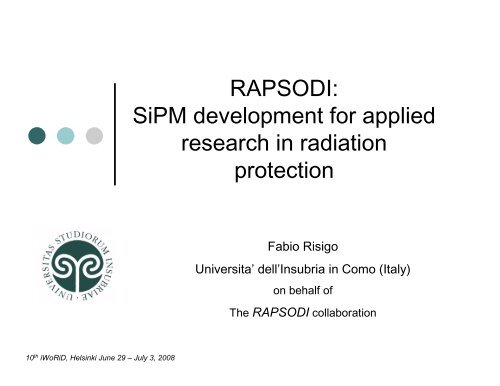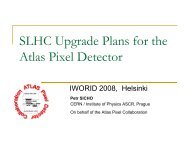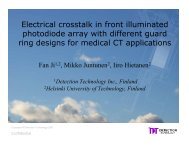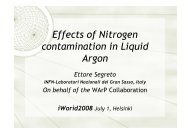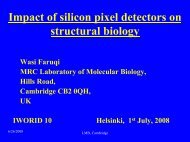July 3 (2008) - Helsinki Institute of Physics
July 3 (2008) - Helsinki Institute of Physics
July 3 (2008) - Helsinki Institute of Physics
Create successful ePaper yourself
Turn your PDF publications into a flip-book with our unique Google optimized e-Paper software.
RAPSODI:<br />
SiPM development for applied<br />
research in radiation<br />
protection<br />
Fabio Risigo<br />
Universita’ dell’Insubria in Como (Italy)<br />
on behalf <strong>of</strong><br />
The RAPSODI collaboration<br />
10 th iWoRiD, <strong>Helsinki</strong> June 29 – <strong>July</strong> 3, <strong>2008</strong>
RAPSODI: RAdiation Protection with<br />
Silicon Optoelectronic Devices and<br />
Instruments<br />
Funded by the EC under the Sixth Framework Program (Co-operative research)<br />
Start-time Oct 2006; End-time Jan 2009<br />
Main objectives: Silicon Photo Multipliers development and optimization for three<br />
well defined applications: Dosimetry in Mammography, Radon Monitoring, illicit<br />
traffic <strong>of</strong> radioactive material (homeland security)<br />
4 Small and Medium Enterprises + 3 R&D performers<br />
SensL (IE)<br />
Specialized in SiPM development<br />
PTW (DE)<br />
Leader in EU market <strong>of</strong> radiation monitor & dosimeter<br />
Plch SMM (CZ)<br />
Leader in Radon meter construction<br />
ForimTech (CH)<br />
Small start-up with a focus on photon sensing<br />
technologies and detectors assembly<br />
UNICO (IT)<br />
Leading partner<br />
AGH (PL)<br />
Microelectronic <strong>Institute</strong><br />
ITEP (RU)<br />
Long standing tradition in SiPM<br />
Significant characterization parameters <strong>of</strong> SiPM and the dosimetry measurements in mammography<br />
10 th iWoRiD, <strong>Helsinki</strong> June 29 – <strong>July</strong> 3, <strong>2008</strong>
Silicon Photon Multiplier<br />
SiPM = High density (~10 3 /mm 2 ) matrix <strong>of</strong> diodes with a common output, working in<br />
Geiger-Müller regime<br />
advantages over traditional photo-detectors:<br />
<br />
<br />
<br />
high sensitivity (single photon discrimination)<br />
high speed (T rise<br />
~ 1 ns; T fall<br />
~ 50 ns)<br />
compactness, robustness, low operating<br />
voltage and power consumption, low cost<br />
Matrix <strong>of</strong> binary elements allows an analog<br />
measurement, counting the number <strong>of</strong> hit cells<br />
Producer<br />
Area (mm 2 )<br />
Pixel size<br />
(µm)<br />
No. cells<br />
V working<br />
DCR<br />
GAIN<br />
PDE (%)<br />
(green)<br />
SensL<br />
3 x 3<br />
20 x 20<br />
8640<br />
30<br />
6 MHz<br />
10 6<br />
10<br />
Hamamatsu<br />
1 x 1<br />
17 x 14<br />
1600<br />
77<br />
220 kHz<br />
3 x 10 5<br />
20<br />
CPTA<br />
1 x 1<br />
30 x 30<br />
500<br />
24<br />
3 MHz<br />
10 6<br />
30<br />
SensL is developing custom oriented SiPM<br />
10 th iWoRiD, <strong>Helsinki</strong> June 29 – <strong>July</strong> 3, <strong>2008</strong>
Full characterization protocol<br />
<br />
<br />
<br />
<br />
I-V measurements (leakage current, quenching resistor, breakdown voltage)<br />
Noise measurements (vs over voltage and vs temperature):<br />
<br />
<br />
dark counting rate (DCR) vs bias voltage<br />
optical cross-talk (DCR vs threshold)<br />
Analysis <strong>of</strong> (Poissonian photon) spectrum (vs temperature)<br />
<br />
<br />
<br />
<br />
resolution power (how many photons can I distinguish?) & gain<br />
working point optimization (at low and large flux)<br />
noise measurement (not DCR)<br />
optical cross-talk (deviations from the Poissonian distribution)<br />
linearity & dynamic range<br />
Spectral response (PDE vs , PDE vs temperature)<br />
<br />
timing properties and time resolution (not relevant for RAPSODI but in progress)<br />
10 th iWoRiD, <strong>Helsinki</strong> June 29 – <strong>July</strong> 3, <strong>2008</strong>
Photon Spectrum & Gain<br />
Light source: Pico Quant PDL 800 - light at ~ 510 nm (green)<br />
G<br />
= ∆<br />
peak −<br />
QDC<br />
e ⋅ k<br />
cal<br />
AMP<br />
peak<br />
<br />
<br />
<br />
good resolution power<br />
Gain<br />
Noise (NOT DCR!)<br />
measurement (width <strong>of</strong><br />
single pulse)<br />
width count<br />
> 20 peaks<br />
10 th iWoRiD, <strong>Helsinki</strong> June 29 – <strong>July</strong> 3, <strong>2008</strong>
Dark Count Rate & X talk<br />
DCR @ different thresholds on the output signal to be digitalized<br />
Dark Counting Rate (DCR) is the<br />
rate at which a Geiger avalanche is<br />
randomly initiated by thermal<br />
emission.<br />
> 0.5 ph<br />
> 1.5 ph<br />
Threshold scan<br />
0.5 ph<br />
1.5 ph<br />
2.5 ph<br />
DCR @ fixed threshold (0.5 phe-)<br />
> 2.5 ph<br />
Increasing the bias, the GM probability increases<br />
10 th iWoRiD, <strong>Helsinki</strong> June 29 – <strong>July</strong> 3, <strong>2008</strong><br />
the avalanche generation can generate an<br />
avalanche in a near cell through a photon;<br />
measuring the DCR for different thresholds is<br />
possible to define and evaluate the Optical<br />
Cross talk as:<br />
X talk<br />
=<br />
DCR(1.5<br />
ph)<br />
DCR(0.5<br />
ph)
Photon Detection Efficiency<br />
n<br />
_ cell<br />
=<br />
n<br />
ph<br />
⋅ QE<br />
⋅<br />
FillFactor<br />
⋅<br />
p<br />
GM<br />
PDE<br />
Pico Quant<br />
PDL 800<br />
Ligth guide<br />
Ø 1 mm<br />
clear fiber<br />
(divergence 15°)<br />
FC<br />
connector<br />
SiPM<br />
sensor<br />
Light calibrated against PMT (H5783) and<br />
tuned to have 200 ph/burst<br />
FC to guarantees the reproducibility <strong>of</strong> the fiber tip to SiPM<br />
surface distance and alignment (acceptance control)<br />
The PDE has to be corrected for the<br />
Optical Cross Talk as:<br />
n = n ⋅ 1+<br />
_ meas<br />
_ cell<br />
( X )<br />
talk<br />
10 th iWoRiD, <strong>Helsinki</strong> June 29 – <strong>July</strong> 3, <strong>2008</strong>
Temperature Dependence<br />
Pico Quant PDL 800 – light @ ~ 510 nm<br />
Cooling Box + Temperature control<br />
Gain vs bias voltage<br />
Gain vs temperature<br />
for any specific working conditions you have a non trivial depend on the<br />
temperature, due to the variation <strong>of</strong> the V BD<br />
(against temperature)<br />
re-scaling the<br />
breakdown<br />
voltage<br />
dV<br />
V<br />
BD<br />
= ( T −TRT<br />
) + V<br />
dT<br />
RT<br />
normalizing all the measurements, you obtain a remarkable linear<br />
dependence against over voltage and a very little spread vs temperature<br />
Gain independent from<br />
temperature as function <strong>of</strong><br />
over voltage<br />
Results particularly important once you have to guarantee the stability <strong>of</strong> an instrument as the environmental<br />
conditions change<br />
10 th iWoRiD, <strong>Helsinki</strong> June 29 – <strong>July</strong> 3, <strong>2008</strong>
An Application: Dosimetry in<br />
mammography<br />
Dosimetry in mammography is<br />
utmost important and this is<br />
somehow proven by the ongoing<br />
debate on the relevance <strong>of</strong><br />
mammography screening<br />
…but currently existing<br />
instruments are limited:<br />
Standard Termo-Luminescent<br />
Detectors require to be analyzed after<br />
examination, degrade with time<br />
MOSFET detectors suffer from low<br />
stability and degrade with each irradiation<br />
Ionization chamber devices need<br />
relatively high voltage (cannot be used in<br />
contact with the patient), not tissue<br />
equivalent<br />
10 th iWoRiD, <strong>Helsinki</strong> June 29 – <strong>July</strong> 3, <strong>2008</strong><br />
precise measurements <strong>of</strong> the<br />
actual dose being received by a<br />
patient without distorting the X-ray<br />
beam and introducing any<br />
artefacts in the image<br />
Some functional requirements:<br />
dose rate range (2 ÷ 150 mGy/s)<br />
dose range minimum (0.5 mGy)<br />
sensitivity (5%)<br />
overall accuracy (±10%)<br />
tolerance to environmental<br />
variation & stability
The Prototype<br />
Designed and tested prototype @ PTW – secondary standard lab for dosimetry:<br />
Scintillator<br />
(tile or fiber)<br />
Ligth guide<br />
Ø 1 mm<br />
clear fiber<br />
FC connector &<br />
SiPM<br />
Electronics<br />
PHISYCAL OBSERVABLE:<br />
“buffered” signal sum<br />
Sum <strong>of</strong> samples signals selected<br />
by an edge detector algorithm + left<br />
& right buffer<br />
-> proportional to the DOSE<br />
Trace plot: typical mammo SiPM output<br />
(continuous photons flux – pulse duration <strong>of</strong> each sample100 ms)<br />
BUFFERED<br />
SUM<br />
10 th iWoRiD, <strong>Helsinki</strong> June 29 – <strong>July</strong> 3, <strong>2008</strong><br />
~TIME
Result summary<br />
Two different set-up (optimized for dynamic range & ):<br />
1mm scintillator tile coupled with SensL SiPM (9k cells, 3x3 mm 2 )<br />
Blue scintillator fiber coupled with Hamamatsu (400 cells, 1x1 mm 2 )<br />
Irradiation: 0,22 ÷ 217 mGy/s<br />
Tile +<br />
SensL<br />
Fiber +<br />
Hamamatsu<br />
Precision(%)<br />
1.95 ± 0.05<br />
2.31 ± 0.03<br />
Sensitivity A<br />
(mGy/s)<br />
2.60 ± 0.05<br />
2.05 ± 0.03<br />
MDS B (mGy/s)<br />
0.524 ± 0.009<br />
0.458 ± 0.007<br />
Linear<br />
Dinamic range<br />
(mGy/s)<br />
160<br />
> 200<br />
A<br />
Sensitivity: Precision / system gain<br />
B<br />
MDS: minimum signal distinguishable from the noise<br />
10 th iWoRiD, <strong>Helsinki</strong> June 29 – <strong>July</strong> 3, <strong>2008</strong>
Conclusions<br />
<br />
<br />
<br />
Within the RAPSODI project, a laboratory for SiPM and light sensors<br />
characterization has been setup at the University <strong>of</strong> Insubria. The lab<br />
has developed both the expertise and the instrumentation to perform<br />
all the measurements to fully characterize SiPM.<br />
This expertise has been used also in the test <strong>of</strong> a mammography<br />
dosimeter instrument being developed in collaboration with PTW.<br />
The performances <strong>of</strong> the first MammoDos prototype are according to<br />
specification and this will lead to the final product before the end <strong>of</strong><br />
the project.<br />
! THANK YOU !<br />
10 th iWoRiD, <strong>Helsinki</strong> June 29 – <strong>July</strong> 3, <strong>2008</strong>
Backup slides
Temperature Dependence<br />
SensL 9k: 23.2 mV/°C ± 1.4 mV/°C<br />
Gain independent from<br />
temperature<br />
as function <strong>of</strong> over voltage
Equipment<br />
• USB-VME Bridge CAEN<br />
• V171816ch QDC CAEN V792N<br />
• DC power supply Agilent 6645A<br />
• Scope Agilent 54624A<br />
• Pulse Generator Agilent 33250A [50 MHz]<br />
• Lecroy 821 NIM discriminator<br />
• CAEN NIM level translators<br />
• SensL Board + ZFL-500-BNC [20 dB gain]<br />
• PDL800-B PicoQuant (green LED)<br />
• OZ optics coupler & focuser<br />
• Dark Box +XY stage and manual Z<br />
• Keithley 4200 SCA<br />
• 590 + 595 C-V meters QS+HF
RAPSODI project<br />
<br />
<br />
<br />
Real-time dosimeter for mammography (MAMMODOS): design, construction and<br />
commissioning <strong>of</strong> a real-time instruments to measure the dose released to the breast<br />
during a mammographic procedure.<br />
Apparatus conceptual design, study <strong>of</strong> the interaction <strong>of</strong> X-ray with plastic plate,<br />
dedicated SiPMs Electronics Development & production, first prototype construction and<br />
characterisation and s<strong>of</strong>tware development, final system integration with dedicated SiPM<br />
and laboratory and hospital tests.<br />
Radon concentration meter (RADONPROBE): design, construction and commissioning<br />
<strong>of</strong> a portable real-time detector for Radon indoor and water concentration measurements.<br />
Apparatus conceptual design, gas collector & measuring chamber study, dedicated<br />
electronics and s<strong>of</strong>tware development, construction and characterization <strong>of</strong> the Radon<br />
Probe first prototype and preliminary quality assessment, system integration with<br />
dedicated SiPMs and qualification tests.<br />
Portable radioactivity monitor (MICROSNOOPER): design, construction and<br />
commissioning <strong>of</strong> a very small and cheap portable real-time device to detect and identify<br />
any type <strong>of</strong> radiation.<br />
Apparatus conceptual design, study <strong>of</strong> the interaction <strong>of</strong> different types <strong>of</strong> radiation with<br />
the scintillator, development and tests <strong>of</strong> the prototype device, development and<br />
production <strong>of</strong> a dedicated integrated circuit, development <strong>of</strong> the s<strong>of</strong>tware for device<br />
control and construction qualification and tests <strong>of</strong> the MICROSNOOPER prototype.
I-V measurements<br />
Remarks:<br />
quenching resistor<br />
breakdown voltage<br />
leakage current<br />
DCR
One Application: Dosimetry in<br />
mammography<br />
Real-time dosimetry in mammography: development <strong>of</strong> a dose-meter for<br />
mammography (MAMMODOS), which will allow real time and precise<br />
measurements <strong>of</strong> the actual dose being received by a patient without distorting the<br />
X-ray beam and introducing any artefacts in the image<br />
Mammography is the process <strong>of</strong> using low-dose X-rays (usually around 0.7 mSv) to examine<br />
the human breast. It is used to look for different types <strong>of</strong> tumors, cysts and micro-calcifications.<br />
Existing devices:<br />
Standard Thermo-Luminescent Detectors: they required to be analyzed after the examination;<br />
they degrade with time and need regular replacement (time consuming calibration procedure);<br />
furthermore, since they tend to be positioned upstream <strong>of</strong> the object, they create artifacts on the<br />
image.<br />
MOSFET detectors: they suffer from low stability and degrade with each irradiation. Being<br />
positioned upstream the object they also create artifacts on the image.<br />
Ionization chamber devices: they do not suffer <strong>of</strong> any degradation effect, their outputs is<br />
reliable and stable, but they need relatively high voltage and therefore cannot be used in contact<br />
with the patient during examination, besides that they are definitely not tissue-equivalent.
One Application: Dosimetry in<br />
mammography<br />
SetUp: scintillator (Tile or<br />
Filer) coupled with SiPM<br />
Trace plot: typical mammo SiPM output<br />
(continuous photons flux – pulse duration 100 ms)<br />
boundary conditions:<br />
dose range rate<br />
minimum detectable signal<br />
sensitivity<br />
overall accuracy<br />
Tolerance to environmental variation<br />
& stability<br />
SIGNAL region<br />
PEDESTAL region<br />
~TIME<br />
Numeri e plot linearita’<br />
Minimum Signal Distinguishable from the noise floor ~0.5 mGy/s<br />
Sensitivity ~2 mGy/s


